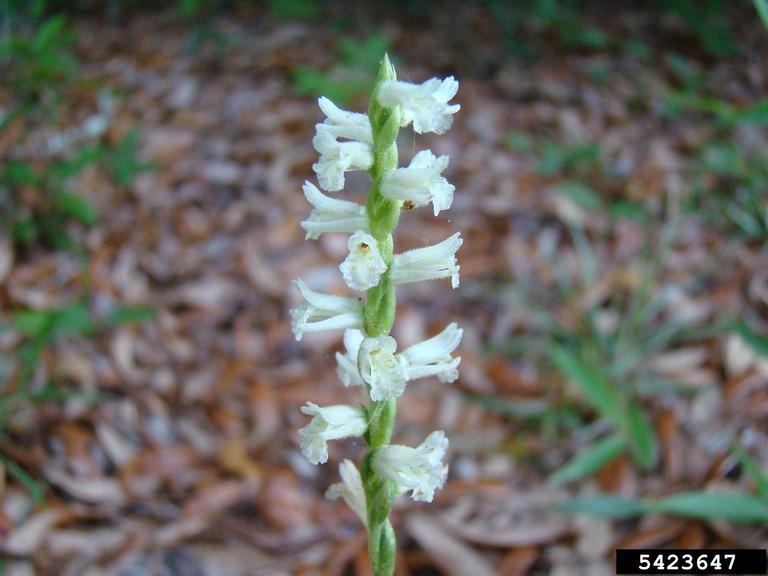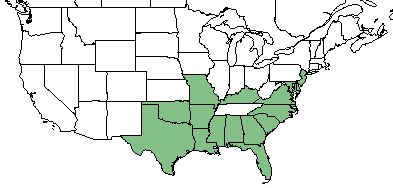Difference between revisions of "Spiranthes praecox"
HaleighJoM (talk | contribs) (→Ecology) |
|||
| (10 intermediate revisions by 7 users not shown) | |||
| Line 17: | Line 17: | ||
| range_map_caption = Natural range of ''Spiranthes praecox'' from USDA NRCS [https://plants.usda.gov/core/profile?symbol=SPFI Plants Database]. | | range_map_caption = Natural range of ''Spiranthes praecox'' from USDA NRCS [https://plants.usda.gov/core/profile?symbol=SPFI Plants Database]. | ||
}} | }} | ||
| − | Common Name(s): grass-leaved ladies’ | + | Common Name(s): grass-leaved ladies’-tresses, giant ladies’-tresses,<ref name="Weakley 2015">Weakley A. S.(2015). Flora of the Southern and Mid-Atlantic States. Chapel Hill, NC: University of North Carolina Herbarium.</ref> greenvein lady’s tresses<ref name="USDA">USDA, NRCS. (2016). The PLANTS Database (http://plants.usda.gov, 10 January 2018). National Plant Data Team, Greensboro, NC 27401-4901 USA.</ref> |
==Taxonomic Notes== | ==Taxonomic Notes== | ||
| − | Synonym(s): ''Ibidium praecox'' | + | Synonym(s): ''Ibidium praecox'' (Walter) House |
==Description== <!-- Basic life history facts such as annual/perrenial, monoecious/dioecious, root morphology, seed type, etc. --> | ==Description== <!-- Basic life history facts such as annual/perrenial, monoecious/dioecious, root morphology, seed type, etc. --> | ||
| − | ''Spiranthes praecox is a monoecious perennial forb/herb.<ref name="USDA"/> | + | ''Spiranthes praecox'' is a monoecious perennial forb/herb.<ref name="USDA"/> It is also known to naturally hybridize with other orchids, like ''S. gracilis''.<ref name="Ames 1903"/> |
==Distribution== | ==Distribution== | ||
| Line 30: | Line 30: | ||
==Ecology== | ==Ecology== | ||
===Habitat=== <!--Natural communities, human disturbed habitats, topography, hydrology, soils, light, fire regime requirements for removal of competition, etc.--> | ===Habitat=== <!--Natural communities, human disturbed habitats, topography, hydrology, soils, light, fire regime requirements for removal of competition, etc.--> | ||
| − | ''S. praecox'' is found in savannas, swamps, and bogs.<ref name="Weakley 2015"/> | + | ''S. praecox'' is found in savannas, swamps, woodlands, meadows, pinelands, dunes, swales, and bogs.<ref name="Weakley 2015"/><ref name="PH"> Academy of Natural Sciences of Drexel University accessed using Southeastern Regional Network of Expertise and Collections (SERNEC) data portal. URL: http://sernecportal.org/portal/collections/index.php Last accessed: June 2021. Collectors: M.L Fernald and H. B. Meredith. States and Counties: Virginia: Norfolk City, Princess Anne, and Virginia Beach City.</ref> |
| + | |||
| + | It is also found in disturbed like including vacant lots.<ref name="PH"/> | ||
| + | |||
| + | Associated species: ''Tradescantia, Amorpha'', and ''Spigelia''.<ref name="LSU"> Louisiana State University, Shirley C. Tucker Herbarium accessed using Southeastern Regional Network of Expertise and Collections (SERNEC) data portal. URL: http://sernecportal.org/portal/collections/index.php Last accessed: June 2021. Collectors: Charles M. Allen. States and Counties: Louisiana: Saint Helena.</ref> | ||
===Phenology=== <!--Timing off flowering, fruiting, seed dispersal, and environmental triggers. Cite PanFlora website if appropriate: http://www.gilnelson.com/PanFlora/ --> | ===Phenology=== <!--Timing off flowering, fruiting, seed dispersal, and environmental triggers. Cite PanFlora website if appropriate: http://www.gilnelson.com/PanFlora/ --> | ||
| − | + | ''S. praecox'' has been observed to flower from March through July<ref name="Weakley 2015"/> with peak inflorescence in April and May. A report of flowering in December also exists<ref name="PanFlora">Nelson, G. PanFlora: Plant data for the eastern United States with emphasis on the Southeastern Coastal Plains, Florida, and the Florida Panhandle. www.gilnelson.com/PanFlora/ Accessed: 16 JAN 2018</ref> and in New England, it is said to complete its bloom by the end of the second week of September.<ref name="Ames 1903">Ames O (1903) Natural hybrids in ''Spiranthes'' and ''Habenaria''. Rhodora 5(59):261-264.</ref> | |
<!--===Seed dispersal===--> | <!--===Seed dispersal===--> | ||
<!--===Seed bank and germination===--> | <!--===Seed bank and germination===--> | ||
| − | + | ===Fire ecology=== <!--Fire tolerance, fire dependence, adaptive fire responses--> | |
| + | Populations of ''Spiranthes praecox'' have been known to persist through repeated annual burning.<ref>Platt, W.J., R. Carter, G. Nelson, W. Baker, S. Hermann, J. Kane, L. Anderson, M. Smith, K. Robertson. 2021. Unpublished species list of Wade Tract old-growth longleaf pine savanna, Thomasville, Georgia.</ref> | ||
<!--===Pollination===--> | <!--===Pollination===--> | ||
| − | <!--=== | + | <!--===Herbivory and toxicology===<!--Common herbivores, granivory, insect hosting, poisonous chemicals, allelopathy, etc--> |
| − | <!--==Diseases and parasites==--> | + | <!--===Diseases and parasites===--> |
| + | |||
| + | ==Conservation, cultivation, and restoration== | ||
| − | == | + | ==Cultural use== |
| − | |||
==Photo Gallery== | ==Photo Gallery== | ||
<gallery widths=180px> | <gallery widths=180px> | ||
</gallery> | </gallery> | ||
==References and notes== | ==References and notes== | ||
Latest revision as of 17:57, 15 July 2022
| Spiranthes praecox | |
|---|---|

| |
| Photo by Rebekah D. Wallace, University of Georgia, Bugwood.org hosted at Forestryimages.org | |
| Scientific classification | |
| Kingdom: | Plantae |
| Division: | Magnoliophyta - Flowering plants |
| Class: | Liliopsida - Moncots |
| Order: | Orchidales |
| Family: | Orchidaceae - Orchids |
| Genus: | Spiranthes |
| Species: | S. praecox |
| Binomial name | |
| Spiranthes praecox (Walter) S. Watson | |

| |
| Natural range of Spiranthes praecox from USDA NRCS Plants Database. | |
Common Name(s): grass-leaved ladies’-tresses, giant ladies’-tresses,[1] greenvein lady’s tresses[2]
Contents
Taxonomic Notes
Synonym(s): Ibidium praecox (Walter) House
Description
Spiranthes praecox is a monoecious perennial forb/herb.[2] It is also known to naturally hybridize with other orchids, like S. gracilis.[3]
Distribution
This species is endemic to the Southeastern Coastal Plain, being found from New Jersey, south to southern Florida, and westward to Texas.[1]
Ecology
Habitat
S. praecox is found in savannas, swamps, woodlands, meadows, pinelands, dunes, swales, and bogs.[1][4]
It is also found in disturbed like including vacant lots.[4]
Associated species: Tradescantia, Amorpha, and Spigelia.[5]
Phenology
S. praecox has been observed to flower from March through July[1] with peak inflorescence in April and May. A report of flowering in December also exists[6] and in New England, it is said to complete its bloom by the end of the second week of September.[3]
Fire ecology
Populations of Spiranthes praecox have been known to persist through repeated annual burning.[7]
Conservation, cultivation, and restoration
Cultural use
Photo Gallery
References and notes
- ↑ 1.0 1.1 1.2 1.3 Weakley A. S.(2015). Flora of the Southern and Mid-Atlantic States. Chapel Hill, NC: University of North Carolina Herbarium.
- ↑ 2.0 2.1 USDA, NRCS. (2016). The PLANTS Database (http://plants.usda.gov, 10 January 2018). National Plant Data Team, Greensboro, NC 27401-4901 USA.
- ↑ 3.0 3.1 Ames O (1903) Natural hybrids in Spiranthes and Habenaria. Rhodora 5(59):261-264.
- ↑ 4.0 4.1 Academy of Natural Sciences of Drexel University accessed using Southeastern Regional Network of Expertise and Collections (SERNEC) data portal. URL: http://sernecportal.org/portal/collections/index.php Last accessed: June 2021. Collectors: M.L Fernald and H. B. Meredith. States and Counties: Virginia: Norfolk City, Princess Anne, and Virginia Beach City.
- ↑ Louisiana State University, Shirley C. Tucker Herbarium accessed using Southeastern Regional Network of Expertise and Collections (SERNEC) data portal. URL: http://sernecportal.org/portal/collections/index.php Last accessed: June 2021. Collectors: Charles M. Allen. States and Counties: Louisiana: Saint Helena.
- ↑ Nelson, G. PanFlora: Plant data for the eastern United States with emphasis on the Southeastern Coastal Plains, Florida, and the Florida Panhandle. www.gilnelson.com/PanFlora/ Accessed: 16 JAN 2018
- ↑ Platt, W.J., R. Carter, G. Nelson, W. Baker, S. Hermann, J. Kane, L. Anderson, M. Smith, K. Robertson. 2021. Unpublished species list of Wade Tract old-growth longleaf pine savanna, Thomasville, Georgia.